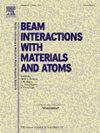Yield behavior of ion-irradiated metal and alloys measured by nanoindentation
IF 1.4
3区 物理与天体物理
Q3 INSTRUMENTS & INSTRUMENTATION
Nuclear Instruments & Methods in Physics Research Section B-beam Interactions With Materials and Atoms
Pub Date : 2025-04-26
DOI:10.1016/j.nimb.2025.165717
引用次数: 0
Abstract
In general, ion irradiation produces a shallow damaged layer beneath the surface of materials. The yield behavior and mechanism of this irradiation-damaged layer are still not clear, and there is a scarcity of techniques for assessing the mechanical properties of such minute volumes material. In this paper, a nanoindentation stress–strain relationship is established to investigate the yield behavior of ion-irradiated materials including Be, Fe-10Cr and CuAlMn alloys. The findings indicate that the initial yield stress of ion-irradiated layer in which dislocation loops and/or cavities are present increase, and even a significant yield platform can be observed through the established nanoindentation stress–strain curves. Additionally, the difference in yield behavior caused by the phase transformation can also be clearly reflected. This underscores the utility of the established indentation stress–strain relationship in providing insights into the elastic–plastic properties of ion irradiated materials.
用纳米压痕测量离子辐照金属和合金的屈服行为
一般来说,离子辐照在材料表面下产生一个浅层损伤层。这种辐照损伤层的屈服行为和机制仍然不清楚,并且缺乏评估这种小体积材料力学性能的技术。本文建立了纳米压痕应力-应变关系,研究了离子辐照下Be、Fe-10Cr和CuAlMn合金的屈服行为。结果表明,存在位错环和/或空洞的离子辐照层的初始屈服应力增加,通过建立的纳米压痕应力-应变曲线可以观察到明显的屈服平台。此外,相变引起的屈服行为差异也可以清楚地反映出来。这强调了已建立的压痕应力-应变关系在深入了解离子辐照材料的弹塑性特性方面的实用性。
本文章由计算机程序翻译,如有差异,请以英文原文为准。
求助全文
约1分钟内获得全文
求助全文
来源期刊
CiteScore
2.80
自引率
7.70%
发文量
231
审稿时长
1.9 months
期刊介绍:
Section B of Nuclear Instruments and Methods in Physics Research covers all aspects of the interaction of energetic beams with atoms, molecules and aggregate forms of matter. This includes ion beam analysis and ion beam modification of materials as well as basic data of importance for these studies. Topics of general interest include: atomic collisions in solids, particle channelling, all aspects of collision cascades, the modification of materials by energetic beams, ion implantation, irradiation - induced changes in materials, the physics and chemistry of beam interactions and the analysis of materials by all forms of energetic radiation. Modification by ion, laser and electron beams for the study of electronic materials, metals, ceramics, insulators, polymers and other important and new materials systems are included. Related studies, such as the application of ion beam analysis to biological, archaeological and geological samples as well as applications to solve problems in planetary science are also welcome. Energetic beams of interest include atomic and molecular ions, neutrons, positrons and muons, plasmas directed at surfaces, electron and photon beams, including laser treated surfaces and studies of solids by photon radiation from rotating anodes, synchrotrons, etc. In addition, the interaction between various forms of radiation and radiation-induced deposition processes are relevant.

 求助内容:
求助内容: 应助结果提醒方式:
应助结果提醒方式:


